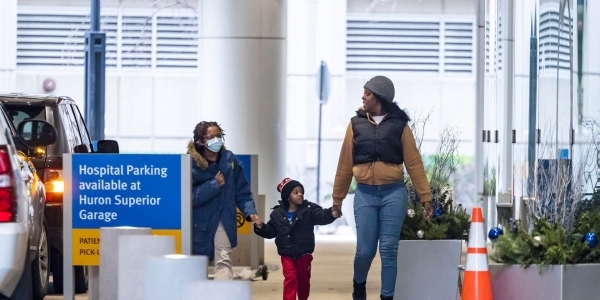
I have deep sympathy every time I walk into my children’s pediatric practice in Manhattan. The place seems short-staffed, everyone is working around the clock, and the needs of our kids continue to mount.
What pediatricians have done for our children over the last three years, as the pandemic raged on and kids continued to be overlooked for vaccines and other remedies, is nothing short of a miracle. However, as a society, we’re ignoring pediatric health to the detriment of parents, kids, and medicine as a whole.
In my role as the CEO of a pediatric telehealth platform, I’ve had the unfortunate reality of witnessing the system continue to fail our parents at an alarming rate. I’m constantly reminded of the countless hours parents spend away from work every year to take care of a sick child.
I see school closures taking place because 32% of the school population has the flu. And I think about the impossible tradeoff parents have to make between getting urgent medical care for an average of $2,032 per visit, or feeding their families.
Health systems do not find pediatric care lucrative and are downsizing pediatric units and practices
Pediatric hospitals, children’s floors in emergency departments, and peds-based urgent medicine practices are shrinking at an alarming rate. This is a phenomenon that began well before the pandemic.
The American Academy of Pediatrics estimates that between 2008-2018, pediatric inpatient units shrank by almost 20%. The pandemic exacerbated this trend, as hospitals converted children’s floors into adult urgent care centers to treat older patients for COVID.
The unfortunate reality is that it comes down to economics. Health systems realize that they can generate more income on a bed filled with an elderly patient or an adult rather than with a child. As a result, parents in rural areas are forced to drive across state lines or for up to eight hours to get consistent medical care for their children. This phenomenon stems from the fact that reimbursement rates are lower for children from Medicaid and CHIP, which cover over 40% of children in the U.S. Additionally, adults are subject to more expensive tests and procedures.
COVID and cutbacks caused immense strain on the medical system
The last three years have put tremendous strain on the healthcare system, resulting in a shortage of hospital beds and providers. As we stare into a likely downturn, economic headwinds have made it difficult for many hospitals and healthcare providers to financially recover from the strain they experienced during the pandemic.
In conjunction with downsizing pediatric availability, kids are disproportionately suffering from common conditions, notably RSV and the flu, because they were not exposed to them over the last two winters. Infections were up over 30% this year–and we are facing shortages of pediatric formulations of key medicines such as acetaminophen, ibuprofen, amoxicillin, and Tamiflu to treat respiratory illnesses. Due to hospital bed shortages and physician fatigue, the system is unable to meet the demand from parents seeking care for their children.
Almost 20% of Americans delayed some form of medical care during the pandemic. As a result, the system remains overburdened as these conditions worsened and people decided that they need to catch up on the healthcare they had overlooked.
A brewing mental health crisis is affecting children and carers
The mental health crisis amongst teens isn’t news. Suicide rates among teens climbed steadily over the decade between 2010-2020. However, the pandemic deeply exacerbated this trend. An inability to see friends, rising inequality, lack of childcare, and health scares put irreversible strain on both children and parents.
Visits to emergency departments for pediatric mental health concerns increased by 24% for children aged five to 11 and 31% for children aged 12-17, causing a backlog in our emergency medicine system as well.
Physicians have joined the Great Resignation
Physicians are starting to feel the effects of three years of nonstop frontline work. It’s no surprise that one in five physicians say they plan to resign by the end of 2023. Pediatricians particularly suffer from tremendous burnout: over 61% cite feeling burnt out by a constant state of panic in their role over the last three years.
The crunch for pediatric care is inevitable. The system can’t sustain the mismatch of pediatrician supply and demand from parents for their sick kids. With fewer options, parents are forced to turn to more expensive options for care, including going to urgent care or the emergency room.
I remain optimistic. New solutions and technologies can both offer instant access to medical care and provide a more sustainable working environment for pediatricians. By focusing on innovation, we can provide for the health and wellness of the next generation while maintaining the sanity of their parents.
Ellen DaSilva is the founder and CEO of Summer Health, which offers message-based pediatric medical service, and the co-author of Pitching & Closing: Everything You Need To Know About Business Development, Partnerships, and Making Deals that Matter.
The opinions expressed in Fortune.com commentary pieces are solely the views of their authors and do not necessarily reflect the opinions and beliefs of Fortune.
More must-read commentary published by Fortune:
- Elon Musk knows what he’s doing. Here’s the real value he sees in Twitter
- Americans think wages should rise to match inflation–and they’re right. It’s time to dispel the wage-price spiral myth
- Will the U.S. and Europe slide into recession in 2023? Here’s how to look out when economic outlooks don’t
- Biden crowned world energy czar as diplomacy triumphs over Putin’s tantrums





